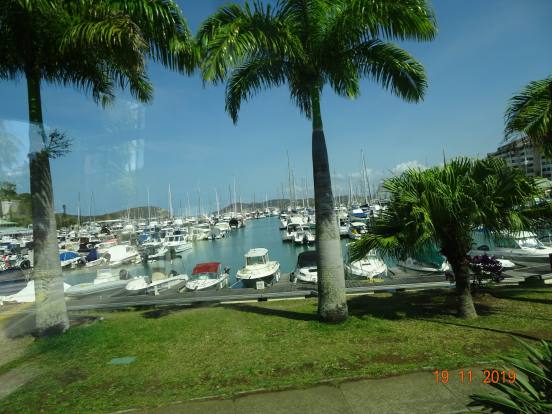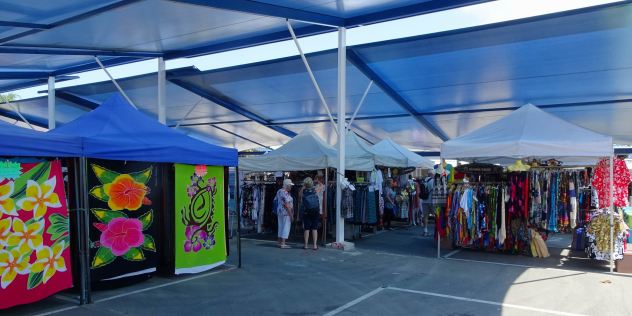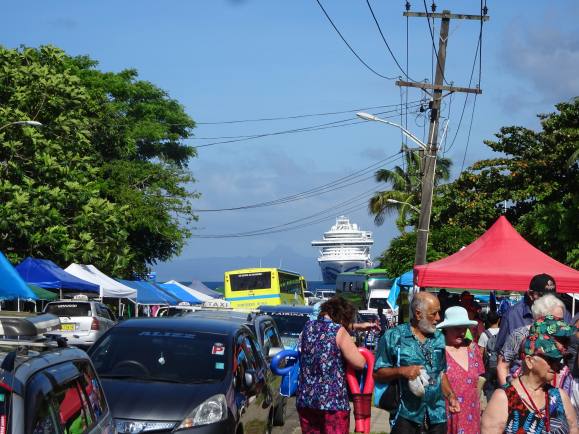
Sunrise over New Caledonia
For a time I was in a business partnership with a Frenchman, who lived in Tahiti and later moved to New Caledonia before finally moving to Sydney.
I can remember him saying that for a Frenchman working for the French government and being posted to one of the French colonies in the Pacific, which includes Tahiti and New Caledonia, as a ‘Hardship’ posting, which entitled them to extra allowances and benefits to make life that little bit easier.

During our recent cruise in Ruby Princess we visited New Caledonia and in particular Noumea, originally called Port-de France until 1866 when it was changed, I took the above picture to show what French’ hardship positing’ personnel have to put up with during their time in Noumea. The above only shows the smaller ‘hardships’.

Ken must have had the same ‘hardship’ thoughts because his picture shows a different set of moorings, and the exotic apartments overlooking the water.
Maureen and I had visited Noumea about twenty three years ago – we enjoyed our few days (it was a business trip for me) and we stayed in the beach area. We didn’t find the city centre to be an attractive place for visitors but overall, we enjoyed our visit.
This time the cruise company offered a hop on hop off bus service for AUD $15 per person, so we thought we’d have another look around. The ship’s buses had colour stickers in the front window to differential them from the normal hop on hop off buses. The system worked well – we boarded the bus at the ship’s gangway, and our first stop was the market, which was our choice.

The market area with the distinctive roofs

There were stalls outside and inside was a fruit and veg market.

Much of the outside area was under a tent like structure which helped to keep one out of the hot sun.

At first glance I thought this stall was offering hub caps for sale, until I got closer.

They were a type of wind chimes or sun reflectors for BBQ / garden areas.

I like to wonder round food markets to see what is different and to compare prices with the same item back home, which is more Maureen’s domain than mine.

The shaped roof was a landmark that could be seen along the waterfront. The market is known as the Port Moselle Market –

Picture from New Caledonia Travel
We were too late for the fish display, which had closed, and of the baked cakes etc there were only a couple of stalls still open, but we still experienced the ‘feel’ of the place.
We waited for one of the buses with the correct colour displayed in the window because we had decided to go to the ‘end of the line’ or the place were bus start its return journey. The full trip from the ship to the return was about 45 to 60 minutes.

Transport was a modern air-conditioned vehicle. Each passenger had a coloured wrist band so the driver could refuse those without the correct colour.

There are also ‘Tchou Tchou’ road trains, which run around the town and beach areas.


Which colour would you like?

These trains have been going for years – when Maureen and I visited in 2000 I can remember using the yellow one from the beach area (where we stayed) to the city centre.
 We crossed the road from where the bus stopped, and this brought back memories of twenty years ago. We’d stayed at the hotel were the bus waited, can’t remember the name of the hotel at that time, but it was the same hotel, now called the Nouvata Hotel.
We crossed the road from where the bus stopped, and this brought back memories of twenty years ago. We’d stayed at the hotel were the bus waited, can’t remember the name of the hotel at that time, but it was the same hotel, now called the Nouvata Hotel.

Along the beach at various points they had shelters, which contained benches and long tables. On our first visit I even went swimming at this point, and that wasn’t a ‘hardship.’

Once back in the city we had a walk around Coconut Palm Square.
 Eight meters (26 feet) high with a semi-nude lady on the top – and known as the Celestial Fountain. Inaugurated on the 24th September 1893.
Eight meters (26 feet) high with a semi-nude lady on the top – and known as the Celestial Fountain. Inaugurated on the 24th September 1893.

Same park, but not a coconut in sight.
New Caledonia was named as such, thanks to Captain Cook, in 1774 because the island reminded him of Scotland. In 1788 the island was approached by Jean François de Galaup, comte de Lapérouse shortly before he went missing, presumed killed in the Solomon Is.
There is a suburb in Sydney named after Lapérouse, who arrived in Australia on the 26th January 1788 (Australia Day), he was on a scientific expedition under instructions from King Louis XVI of France.
A number of people in France applied to join Lapérouse’s expedition, and one sixteen-year-old second lieutenant applied, but was turned down, he was Napoleon Bonaparte- how history might have been different.
The Coconut Palm Square was part of a military facility, and named as such, due to the French soldiers planting coconuts in the area, and the locals would refer to the area as “Place des Cocotiers”. (Coconut Tree Square).
It was in 1855 that Paul Coffyn, a brilliant engineer, was put in charge of drawing the first urban plans for what the future city of Port-de France (now called Noumea) would look like. At that time ‘Place des Cocotiers’ was part of the ocean.
Embankments were built to stop the sea coming in and the new land area was called “jardin de l’infanterie marine” (the marine infantry gardens), until they planted the coconut trees.
The day was interesting and enjoyable and well worth the $15 . .. . .

Farewell Noumea, what a ‘hardship’ location . . . .





















